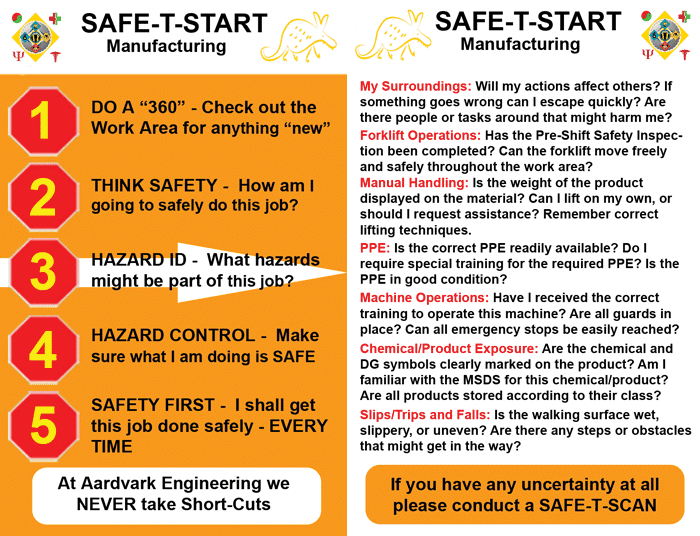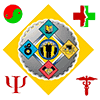
The SAFE-T-START© Card
SAFE-T-START

The SAFE-T-START© Card is a pocket reference card which is required to be carried by all employees. The purpose of the SAFE-T-START© Card is to focus an employee on a range of issues relating to the work task about to be performed. Through the active and continued encouragement of the use of the SAFE-T-START© Card, by all employees, we are aiming to minimize the use of the “auto-pilot” functions associated with occupational performance.
Why do we need to encourage the use of the SAFE-T-START© Card?
Far to often employees go about doing a task just like they always have. What this can mean, quite often, is they pay little attention to a myriad of “things” that might be different from the last time. They just launch in to “tried and tested” work behaviours. That’s good, as long as everything is static and there is no need to consider “change”.

What we know about modern accident causation is that our relationship with job tasks is NEVER static. There is always something happening. For the most part, we get away with these changes by a sense of unconscious adaptation. The level and appropriateness of that “adaptation” may be impacted by experience etc. The dilemma here is for many the greater the level of experience the greater the level of “auto-pilot”.
The SAFE-T-START© Card takes the employee through a staged exploration of common hazards associated with a range of work tasks. TransformationalSafety.Com develops unique SAFE-T-START© Cards for different areas of the workforce. For example the SAFE-T-START© Card required by an Electrician might be quite different to what would be required for a Painter.
It is the back of the SAFE-T-START© Card that walks the employee through a number of simple Hazard Identification exercises – and then focuses upon implementing appropriate control measures. By so doing we are actually intervening at the pre-behaviour stage.

If we were to consider the traditional A-B-C framework of BBS, the SAFE-T-START© Card intervenes at the Activator/Antecedent stage. By so doing it ensures that the subsequent behaviour is actually considered, rather than autonomic (auto-pilot).
Another key element of the SAFE-T-START© Card is that it does not ask the worker to tick a box. So often, we find that ticking a box quickly becomes “box ticking”. A process that has no forebrain engagement. There is an excellent review of the Take 5 process by Jop Havinga et.al. in the journal Safety. Their conclusion was:-
“….we found no evidence to support any of the purported mechanisms by which Take 5 might be effective in reducing the risk of workplace accidents. Take 5 does not improve the planning of work, enhance worker heedfulness while conducting work, educate workers about hazards, or assist with organisational awareness and management of hazards.”
To read their complete review just Click Here.
By actually using transformational influencing skills to encourage the active adoption of this simple card – its influence can become inspirational. The SAFE-T-START© card has been delivered in mutliple languages on the same site. We have witnessed work teams standing about exploring/discussing approaches to work tasks whilst using the SAFE-T-START© card as a cogntive template.
To read more about the SAFE-T-SOS Psycho-Behavioral Technologies just Click Here.
“Most organizations operate in failure states and that just remains invisible because bad stuff is not happening. We might call that the ‘normalization of deviance’ and, make no mistake, it will kill.”

Ricky, Atlanta
![]()
“I was fortunate to attend Transformational Safety’s Anatomies of Disaster Program. This was amongst the most powerful two days I have ever spent in a room. From the outset David Broadbent set the scene by dedicating the program to the late Rick Rescorla – the man who is credited with saving over 2700 lives on 9/11. Throughout the two days David would often respectively reflect and remember those who had died, or been injured, in the disasters we explored. He would say, and I will never forget, “…we must always remember those that lost their lives lift us up into the light of understanding”. I learnt so much. HRO, Resilience Engineering, Critical Incident Stress Management (CISM) and more. Those of us who were there are still talking about it…… Thankyou David


